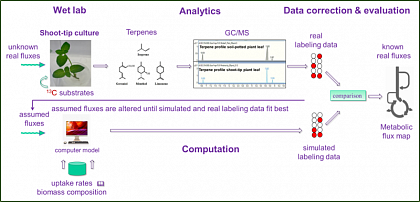Metabolic flux phenotyping of secondary metabolism
Manish L. Raorane, Reza Chamansara
The plant kingdom produces a vast array of natural products, including terpenes, which have various medical benefits. These terpenes are synthesized through two primary pathways: the plastidic methyl erythritol 4-phosphate (MEP) pathway and the cytosolic mevalonate (MVA) pathway. While traditionally thought to be exclusive to specific types of terpenes, recent studies have shown interactions between these pathways. Light plays a significant role in regulating terpene biosynthesis, influencing gene expression and pathway activity.
Our research focuses on the Lamiaceae family of plants, such as peppermint, oregano, and holy basil to study the metabolic pathways involved in terpene production. We employ isotopic tracer analysis, steady-state 13C metabolic flux analysis (13C-MFA), and pathway inhibition studies to measure the metabolic fluxes of primary and isoprenoid metabolism, under varying light conditions. Our findings provide novel insights into glandular trichome metabolism by confirming and quantifying the crosstalk between the two isoprenoid pathways toward terpene biosynthesis.
This study highlights the importance of understanding the complex metabolic networks involved in terpene biosynthesis and how environmental cues influence these processes.

Metabolic Flux Analysis for Terpenes (click to enlarge).




